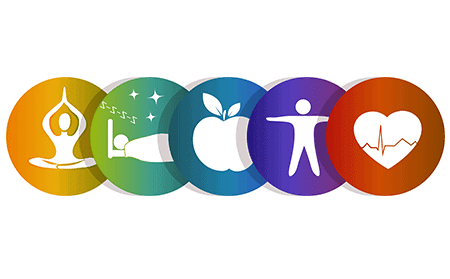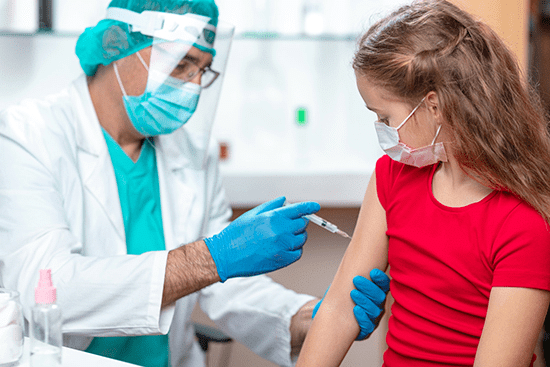NCERT Solutions for Class 9 Science - Why do we fall ill?
Page No. 178
Q.1. State any two conditions essential for good health.
Ans. The conditions essential for good health are:
(a) Proper nutrition or balanced diet and one should be disease-free.
(b) Social equality and harmony are necessary for an individual’s good health.
 Q.2. State any two conditions essential for being free of diseases.
Q.2. State any two conditions essential for being free of diseases.
Ans. Two conditions essential for being disease-free are:
(i) Eating nutritious and balanced food.
(ii) Personal and community hygiene.
Q.3. Are the answers to the above questions necessarily the same or different? Why?
Ans.
- To some extent, they are the same, because if the conditions that are essential for good health are maintained, then automatically the chances of getting a disease will be minimized.
- But at the same time, we can say that they are different because being healthy means physical, mental and social well-being while being disease-free means not suffering from any disease(s).
Page No. 180
Q.1. List any three reasons why you would think that you are sick and ought to see a doctor. If only one of these symptoms were present, would you still go to the doctor? Why or why not?
Ans. Common symptoms which indicate sickness are:
(i) Headache
(ii) Cough
(iii) Dysentery
(iv) Fever
If I experience any one of the above symptoms, I’ll immediately go to the doctor. It is because many of these symptoms can be a sign of sickness or disease. Ignoring it may lead to increase in the disease.
Q.2. In which of the following case do you think the long-term effects on your health are likely to be most unpleasant?
(a) If you get jaundice.
(b) If you get lice.
(c) If you get acne. Why?
Ans. If I have lice and acne, it will not have a long-term effect on my body. But if I get jaundice, it will result in drastic long-term effects. Its symptoms will include high temperature, headache, joint pains, loss of appetite, nausea, and vomiting. Moreover, I may even get irritating rashes. Apart from that, I will have generally poor health for some days which will require complete bed rest for recovery.
Page No. 186
Q.1. Why are we normally advised to take bland and nourishing food when we are sick?
Ans. The immune power of the body decreases during diseases or infections. Therefore, bland or easily digested food is eaten and nourishing food helps in strengthening the immune system.
Q.2. What are the different means by which infectious diseases are spread?
Ans. The different modes of transmission of infectious diseases are as follows:
1. Direct Transmission
(i) By direct contact: Diseases like AIDS, leprosy, skin, eye infections are transmitted by direct contact with the source.
(ii) By droplets: Diseases like respiratory infections, common cold, diphtheria, tuberculosis, etc., are transmitted by droplets.
(iii) By contact with soil: Soil has disease-causing agents like hookworm larvae, etc., that cause diseases like tetanus.
(iv) By inoculation: Inoculation into the skin through contaminated needles and syringes, etc., of the rabies virus, syphilis, hepatitis B, AIDS, etc.
2. Indirect Transmission
Indirect transmission by disease-causing microbes takes place through vectors like flies, etc. For example, typhoid.
Q.3. What precautions can you take in your school to reduce the incidence of infectious diseases?
Ans. We can take the following precautions in our school to reduce the incidence of infectious diseases by:
(i) Drinking clean and hygienic water.
(ii) Preventing the accumulation of water, anywhere in the school.
(iii) Keeping the toilet neat and clean.
(iv) Avoiding the consumption of uncovered food and other eatables.
(v) Using a handkerchief to cover the mouth while sneezing or coughing.
(vi) Staying away from an infected student.
Q.4. What is immunisation?
Ans. The introduction of any kind of germs (antigens) or microbes into the body of a living being by vaccination to activate the immune system against a particular infection or disease is called immunisation.

Q.5.What are the immunisation programmes available at the nearest health centre in your locality? Which of these diseases are the major health problems in your area?
Ans. Immunisation programmes available at the health centre near our locality are:
(i) Vaccination against chickenpox.
(ii) Vaccination against smallpox.
(iii) Vaccination against hepatitis.
(iv) Vaccination against tuberculosis (BCG vaccine).
(v) Polio vaccination
(vi) DPT vaccination (against diphtheria, pertussis and tetanus)
Out of these, the major health problems in our area are Chickenpox, tuberculosis and hepatitis.
Page No. 187
Q.1. How many times did you fall ill last year? What were the illnesses?
(a) Think of one change you could make in your habits in order to avoid any of most of the above illnesses.
(b) Think of one change you would wish for in your surroundings in order to avoid any of most of the above illnesses.
Ans. I fell ill thrice last year and suffered from the following diseases:
(i) Malaria
(ii) Dysentery
(iii) Viral fever
(a) Change in my habits: Now I always make conscious efforts to remain hygienic and eat covered, clean food and fruits.
(b) Change I would wish for in my surroundings: To prevent accumulation of garbage and dirty water and to keep the surroundings neat, clean and hygienic.
Q.2. A doctor/nurse/health-worker is exposed to more sick people than others in the community. Find out how she/he avoids getting sick herself himself.
Ans. The following steps are taken by the doctors/nurses to avoid getting sick themselves:
(i) Immunisation
(ii) Wearing gloves and masks.
(iii) Taking proteinaceous food to enhance their immunity.
(iv) Taking prophylactic medicine.
(v) Disposing of the blood samples, sputum, etc., safely.
Q.3. Conduct a survey in your neighbourhood to find out what the three most common diseases are. Suggest three steps that could be taken by your local authorities to bring down the incidence of these diseases.
Ans. The following three are the most common diseases in any neighborhood:
Cold and cough, loose motions, and malaria.
Some of the preventive measures that can be taken are:
(a). By drinking fresh, uncontaminated, and clean water.
(b). By maintaining hygienic sanitary conditions.
(c). By educating people about various preventive measures with the help of posters, and pamphlets.
Q.4. A baby is not able to tell her/his caretakers that she/he is sick. What would help us to find out
(a) that the baby is sick?
(b) what is the sickness?
Ans.
(a) The baby is sick can be determined by his/her behavioural changes such as constant crying of baby, improper intake of food, frequent mood changes, etc.
(b) The sickness is determined by symptoms or indications that can be seen in the baby. The symptoms include vomiting, fever, loose motion, paleness in the body, etc.
Q.5. Under which of the following conditions is a person most likely to fall sick?
(a) when she is recovering from malaria.
(b) when she has recovered from malaria and is taking care of someone suffering from chicken-pox.
(c) when she is on a four-day fast after recovering from malaria and is taking care of someone suffering from chicken-pox. Why?
Ans. (c)
- A person is more likely to fall sick when she is on a four day fast after recovering from malaria and is taking care of someone who is suffering from chickenpox. This is because she is fasting during recovery, and her immune system is so weak that it cannot protect its own body from any foreign infection.
- If she is taking care of someone suffering from chickenpox, then she has more chances of getting infected from the chickenpox virus and will get sick again with this disease.
Q.6. Under which of the following conditions are you most likely to fall sick?
(a) when you are taking examinations.
(b) when you have travelled by bus and train for two days.
(c) when your friend is suffering from measles. Why?
Ans. A person can most likely fall sick when his/her friend is suffering from measles. It is a highly contagious disease and can easily be transferred through air and respiration. It is always better to stay away from your friend who is affected with measles, else even you may get infected with the disease.
|
129 videos|567 docs|225 tests
|
FAQs on NCERT Solutions for Class 9 Science - Why do we fall ill?
| 1. What are the types of diseases that affect humans? |  |
| 2. What are the common causes of infectious diseases? |  |
| 3. How can we prevent the spread of infectious diseases? |  |
| 4. What are the lifestyle diseases and how can they be prevented? |  |
| 5. How does the human immune system work to fight against diseases? |  |

















